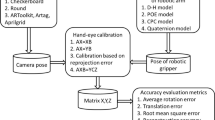Abstract
This paper presents an empirical study investigating the effects of training dataquantity, measurement error, pixel coordinate noise, and the choice of camera model, oncamera calibration accuracy, based on three publicly available techniques, developed byTsai, Heikkilä and Zhang. Results are first provided for asimulated camera system and then verified through carefully controlled experiments using real-world measurements. Our aims are to provide suggestions to researchers who require an immediate solution for camera calibration and a warning of the practical difficulties one may encounter in a real environment. In addition, we offer some insight into the factors to keep in mind when selecting a calibration technique. Finally, we hope that this paper can serve as an introduction to the field for those newly embarking upon calibration-related research.
Similar content being viewed by others
References
Lavest, J.-M., Viala, M., Dhome, M.: Do we really need an accurate calibration pattern to achieve a reliable camera calibration? In: Proceedings of the European Conference on Computer Vision, pp. 158–174 (1998)
Zhang, Z.: A flexible new technique for camera calibration. Technical Report MSR-TR-98-71, Microsoft Research, http://research.microsoft.com/~zhang/Calib/ (1998)
Tsai, R.Y.: A versatile camera calibration technique for high-accuracy 3d machine vision metrology using off-the-shelf TV cameras and lenses. IEEE J. Robotics Automat. 3(4), 323–344 (1987)
Heikkilä, J.: Geometric camera calibration using circular control points. IEEE Trans. Pattern Anal. Machine Intell. 22(10), 1066–1077 (2000)
Zhang, Z.: A flexible new technique for camera calibration. IEEE Trans. Pattern Anal. Machine Intell. 22(11), 1330–1334 (2000)
Salvi, J., Armangué, X., Batlle, J.: A comparative review of camera calibrating methods with accuracy evaluation. Pattern Recognit. 35, 1617–1635 (2002)
Hall, E.L., Tio, J.B.K., McPherson, C.A., Sadjadi, F.A.: Measuring curved surfaces for robot vision. Computer 15(12), 42–54 (1982)
Faugeras, O., Toscani, G.: The calibration problem for stereo. In: Proceedings of the IEEE Conference on Computer Vision and Pattern Recognition, pp. 15–20 (1986)
Weng, J., Cohen, P., Herniou, M.: Camera calibration with distortion models and accuracy evaluation. IEEE Trans. Pattern Anal. Machine Intell. 14(10), 965–980 (1992)
Kanade, T., Rander, P., Narayanan, P.J.: Virtualized reality: constructing virtual worlds from real scenes. IEEE Multimedia, Immersive Telepresence 4(1), 34–47 (1997)
Raskar, R., Welch, G., Cutts, M., Lake, A., Stesin, L., Fuchs, H.: The office of the future: a unified approach to image-based modeling and spatially immersive displays. In: SIGGRAPH 98 Proceedings of the 25th Annual Conference Computer Graphics and Interactive Techniques, pp. 179–188 (1998)
Fusiello, A.: Uncalibrated euclidean reconstruction: a review. Image Vis. Comput. 18, 555–563 (2000)
Chatterjee, C., Roychowdhury, V.P.: Algorithms for coplanar camera calibration. Machine Vis. Appl. 12(2), 84–97 (2000)
Caprile, B., Torre, V.: Using vanishing points for camera calibration. Int. J. Comput. Vis.4(2), 127–140 (1990)
Wei, G., Ma, S.: A complete two-plane camera calibration method and experimental comparisons. In: Proceedings of the 4th International Conference on Computer Vision, pp. 439–446 (1993)
Faugeras, O., Luong, T., Maybank, S.: Camera self-calibration: theory and experiments. In: Proceedings of the European Conference on Computer Vision, pp. 321–334 (1992)
Hartley, R., Zisserman, A.: Multiple View Geometry in Computer Vision. Cambridge University Press, Cambridge (2000)
Bougnoux, S.: From projective to euclidean space under any practical situation, a criticism of self-calibration. In: Proceedings of the 6th International Conference on Computer Vision, pp. 790–796 (1998)
Triggs, B. Autocalibration from planar scenes. In: European Conference on Computer Vision, pp. 89–105 (1998)
Sturm, P., Maybank, S.: On plane-based camera calibration: a general algorithm, singularities, applications. In: Proceedings of the IEEE Conference on Computer Vision and Pattern Recognition, pp. 432–437 (1999)
Liebowitz, D., Zisserman, A.: Metric rectification for perspective images of planes. In: Proceedings of the IEEE Conference on Computer Vision and Pattern Recognition, pp. 482–488 (1998)
Zhang, Z.: Camera calibration with one-dimensional objects. IEEE Trans. Pattern Anal. Machine Intell. 26(7), 892–899 (2004)
Slama, C.C. (ed): Manual of photogrammetry. American Society of Photogrammetry, 4th edn. Falls Church, VA (1980)
More, J.: The Levenberg–Marquardt algorithm, implementation, and theory. In: Watson, G.A. (ed.) Numerical Analysis. Springer-Verlag, New York (1977)
Author information
Authors and Affiliations
Corresponding author
Additional information
Wei Sun received the B.Eng. degree in Electronic Engineering from Shanghai Jiao Tong University in 1995 and the M.Sc. degree in Computer Science from Fudan University in 1998. At present, she is a Ph.D. candidate working at Centre for Intelligent Machines, Department of Eletrical and Computer Engineering of McGill University. Her research interests include image and video processing, computervision, machine learning and computer graphics.
Jeremy R. Cooperstock (Ph.D. Toronto, 1996) is a professor of Electrical and Computer Engineering, a member of the Centre for Intelligent Machines, and a founding member of the Centre for Interdisciplinary Research in Music, Media and Technology at McGill University. Cooperstock is a member of the ACM and chairs the AES Technical Committee on Network Audio Systems. Cooperstock's research interests focus on computer mediation to facilitate high-fidelity human communication and the underlying technologies that support this goal.
Rights and permissions
About this article
Cite this article
Sun, W., Cooperstock, J.R. An empirical evaluation of factors influencing camera calibration accuracy using three publicly available techniques. Machine Vision and Applications 17, 51–67 (2006). https://doi.org/10.1007/s00138-006-0014-6
Received:
Accepted:
Published:
Issue Date:
DOI: https://doi.org/10.1007/s00138-006-0014-6




